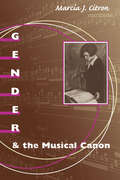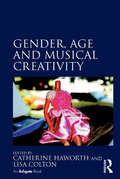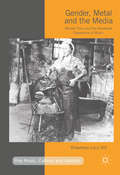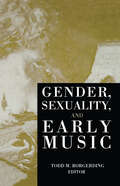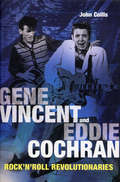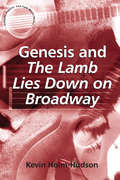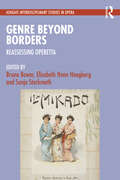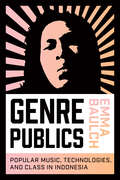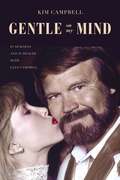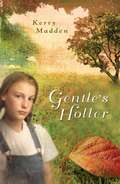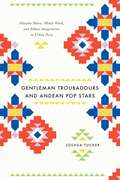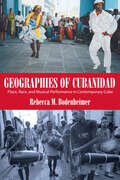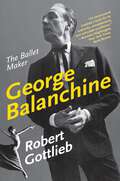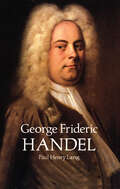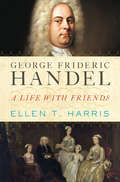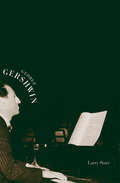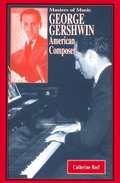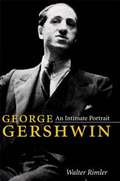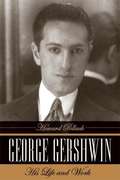- Table View
- List View
Gender and the Musical Canon
by Marcia J. CitronA classic in gender studies in music Marcia J. Citron's comprehensive, balanced work lays a broad foundation for the study of women composers and their music. Drawing on a diverse body of feminist and interdisciplinary theory, Citron shows how the western art canon is not intellectually pure but the result of a complex mixture of attitudes, practices, and interests that often go unacknowledged and unchallenged. Winner of the Pauline Alderman Prize from the International Alliance of Women in Music, Gender and the Musical Canon explores important elements of canon formation, such as notions of creativity, professionalism, and reception. Citron surveys the institutions of power, from performing organizations and the academy to critics and the publishing and recording industries, that affect what goes into the canon and what is kept out. She also documents the nurturing role played by women, including mothers, in cultivating female composers. In a new introduction, she assesses the book's reception by composers and critics, especially the reactions to her controversial reading of Cécile Chaminade's sonata for piano. A key volume in establishing how the concepts and assumptions that form the western art music canon affect female composers and their music, Gender and the Musical Canon also reveals how these dynamics underpin many of the major issues that affect musicology as a discipline.
Gender in the Music Industry: Rock, Discourse and Girl Power (Ashgate Popular And Folk Music Ser.)
by Marion LeonardWhy, despite the number of high profile female rock musicians, does rock continue to be understood as masculine? Why is rock generally assumed to be created and performed by men? Marion Leonard explores different representations of masculinity offered by, and performed through, rock music, and examines how female rock performers negotiate this gendering of rock as masculine. A major concern of the book is not specifically with men or with women performing rock, but with how notions of gender affect the everyday experiences of all rock musicians within the context of the music industry. Leonard addresses core issues relating to gender, rock and the music industry through a case study of 'female-centred' bands from the UK and US performing so called 'indie rock' from the 1990s to the present day. Using original interview material with both amateur and internationally renowned musicians, the book further addresses the fact that the voices of musicians have often been absent from music industry studies. Leonard's central aim is to progress from feminist scholarship that has documented and explored the experience of female musicians, to presenting an analytic discussion of gender and the music industry. In this way, the book engages directly with a number of under-researched areas: the impact of gender on the everyday life of performing musicians; gendered attitudes in music journalism, promotion and production; the responses and strategies developed by female performers; the feminist network riot grrrl and the succession of international festivals it inspired under the name of Ladyfest.
Gender, Age and Musical Creativity
by Lisa Colton Catherine HaworthFrom the perennially young, precocious figure of 'little orphan Annie' to the physical and vocal ageing of the eighteenth-century castrato, interlinked cultural constructions of age and gender are central to the historical and contemporary depiction of creative activity and its audiences. Gender, Age and Musical Creativity takes an interdisciplinary approach to issues of identity and its representation, examining intersections of age and gender in relation to music and musicians across a wide range of periods, places, and genres, including female patronage in Renaissance Italy, the working-class brass band tradition of northern England, twentieth-century jazz and popular music cultures, and the contemporary 'New Music' scene. Drawing together the work of musicologists and practitioners, the collection offers new ways in which to conceptualise the complex links between age and gender in both individual and collective practice and their reception: essays explore juvenilia and 'late' style in composition and performance, the role of public and private institutions in fostering and sustaining creative activity throughout the course of musical careers, and the ways in which genres and scenes themselves age over time.
Gender, Metal and the Media: Women Fans and the Gendered Experience of Music (Pop Music, Culture and Identity)
by Rosemary Lucy HillThis book is a timely examination of the tension between being a rock music fan and being a woman. From the media representation of women rock fans as groupies to the widely held belief that hard rock and metal is masculine music, being a music fan is an experience shaped by gender. <P><P>Through a lively discussion of the idealised imaginary community created in the media and interviews with women fans in the UK, Rosemary Lucy Hill grapples with the controversial topics of groupies, sexism and male dominance in metal. She challenges the claim that the genre is inherently masculine, arguing that musical pleasure is much more sophisticated than simplistic enjoyments of aggression, violence and virtuosity. <P>Listening to women’s experiences, she maintains, enables new thinking about hard rock and metal music, and about what it is like to be a women fan in a sexist environment.
Gender, Metal and the Media: Women Fans and the Gendered Experience of Music (Pop Music, Culture and Identity)
by Rosemary Lucy HillThis book is a timely examination of the tension between being a rock music fan and being a woman. From the media representation of women rock fans as groupies to the widely held belief that hard rock and metal is masculine music, being a music fan is an experience shaped by gender. Through a lively discussion of the idealised imaginary community created in the media and interviews with women fans in the UK, Rosemary Lucy Hill grapples with the controversial topics of groupies, sexism and male dominance in metal. She challenges the claim that the genre is inherently masculine, arguing that musical pleasure is much more sophisticated than simplistic enjoyments of aggression, violence and virtuosity. Listening to women’s experiences, she maintains, enables new thinking about hard rock and metal music, and about what it is like to be a women fan in a sexist environment.
Gender, Sexuality, and Early Music (Criticism and Analysis of Early Music)
by Todd M. BorgerdingThis collection addresses questions of gender and sexuality as they relate to music from the middle ages to the early seventeenth century. These essays present a body of scholarship that considers music as part of the history of sexuality, stimulating conversation within musicology as well as bringing music studies into dialogue with feminist, gender and queer theory. Also includes 20 musical examples.
Gene Vincent & Eddie Cochran
by John CollisThe United Kingdom had never seen anything like it, as two rock'n'roll legends rampaged around the country on Britain's first-ever rock tour. Gene Vincent and Eddie Cochran lived the rock'n'roll lifestyle to the full, bringing to an end the monochrome 1950s and ushering in the swinging 60s.John Collis has traced the story of the UK tour that was a defining moment in British popular culture to its tragic climax with the death of Eddie Cochran. He looks back on the contrasting backgrounds of the two stars, follows the tale onwards to Gene Vincent's death from alcohol and drug abuse, and examines the lasting legacy of their music.
Genesis and The Lamb Lies Down on Broadway (Ashgate Popular And Folk Music Ser.)
by Kevin Holm-HudsonIn 1974 the British progressive rock group Genesis released their double concept album The Lamb Lies Down on Broadway. The story was described by Genesis's then front-man Peter Gabriel as a 'moral fable' about Rael, a half-Puerto-Rican New York City street tough who is engulfed by a solid cloud into a series of strange adventures in a metaphysical realm. The album is a surreal allegory drawing its material from religious, literary and psychological themes. More than thirty years after its release, The Lamb Lies Down on Broadway still enthralls listeners, earning the distinction of being Genesis's most consistently selling back-catalogue release. Kevin Holm-Hudson analyses The Lamb within the context of Genesis's recorded output, within the progressive rock genre as a whole, and within the context of social and political changes of the mid 1970s. The Lamb marked a conscious shift in their story setting to America, and for the first time the songs were oriented to the present rather than the past or future. Significantly, while 1974 marked the peak of music industry growth and consolidation through corporate mergers, it was also the year in which America was confronted with its limits: through the first of the OPEC energy crises, the resignation of Richard Nixon, the withdrawal from Vietnam, and the effects of runaway inflation. Genesis's native Britain was also to feel the effects of the energy crisis, intensified by a period of economic slowdown that ultimately led to the rise of Thatcherism. The Lamb is set in New York City during this time of uncertainty. Within a few years the economic constraints would affect the industry as a whole and as a result progressive rock would suffer a precipitous drop in industry support. The Lamb Lies Down on Broadway thus makes a particularly rich subject for detailed study, providing compelling intersections between the musical, textual and socioeconomic aspects of an album.
Gennett Records and Starr Piano (Images of America)
by Charlie B. Dahan Linda Gennett IrmscherThe Starr Piano Company, based in Richmond, Indiana, quickly became one of the largest piano manufacturers in the United States during the 19th century. In 1915, the Starr Piano Company opened a recording division, Gennett Records, that led to a dynamic change in the music industry and American culture. Gennett embraced the vastly under-recorded genres of jazz, blues, and country music in the 1920s. They recorded artists who were groundbreakers and innovators in both popular and vernacular music, including Louis Armstrong, Charley Patton, Gene Autry, Hoagy Carmichael, Blind Lemon Jefferson, Uncle Dave Macon, and Jelly Roll Morton, often for the first time. The company, like many others, suffered a steep decline in the sale of their pianos and records due to the Great Depression, but the music recorded at Gennett continues to reach new generations and influence musicians as they discover it on reissues and streaming media services.
Genre Beyond Borders: Reassessing Operetta (Ashgate Interdisciplinary Studies in Opera)
by Bruno Bower, Elisabeth Honn Hoegberg, and Sonja StarkmethThis book offers an innovative approach to understanding operetta, drawing attention to its malleability and resistance to boundaries. These shows have traversed (and continue to traverse) with ease the national borders which might superficially define them, or draw on features from many other genres without fundamentally changing in tone or approach. The chapters move from nineteenth-century London and Paris to twentieth-century North America, South America and Europe to present-day Australia. Some offer fresh understandings of familiar composers, such as Johann Strauss or Gilbert and Sullivan, while others examine works or composers that are less well-known. The chapter on Socialist operetta in Czechoslovakia in particular will almost certainly be a revelation to anyone from Western Europe or the US, where operetta is often understood to be a bourgeois phenomenon. As a summary of the current state of the field, this collection showcases the many possible pathways for future scholars who wish to explore it.
Genre Publics: Popular Music, Technologies, and Class in Indonesia (Music / Culture)
by Emma BaulchGenre Publics is a cultural history showing how new notions of 'the local' were produced in context of the Indonesian 'local music boom' of the late 1990s. Drawing on industry records and interviews, media scholar Emma Baulch traces the institutional and technological conditions that enabled the boom, and their links with the expansion of consumerism in Asia, and the specific context of Indonesian democratization. Baulch shows how this music helped reshape distinct Indonesian senses of the modern, especially as 'Asia' plays an ever more influential role in defining what it means to be modern.
Gentle on My Mind: In Sickness and in Health with Glen Campbell
by Kim CampbellThe page-turning, never-before-told story of Kim Campbell's roller-coaster thirty-four-year marriage to music legend Glen Campbell, including how Kim helped Glen finally conquer his addictions only to face their greatest challenge when he was diagnosed with Alzheimer's disease.Kim Campbell was a fresh-faced twenty-two-year-old dancer at Radio City Music Hall when a friend introduced her to Glen Campbell, the chart-topping, Grammy-winning, Oscar-nominated entertainer. The two performers from small Southern towns quickly fell in love, a bond that produced a thirty-four-year marriage and three children.In Gentle on My Mind, Kim tells the complete, no-holds-barred story of their relationship, recounting the highest of highs—award shows, acclaimed performances, the birth of their children, encounters with Mick Fleetwood, Waylon Jennings, Alan Jackson, Alice Cooper, Jane Seymour, and others—and the lowest of lows, including battles with alcohol and drug addiction and, finally, Glen&’s diagnosis, decline, and death from Alzheimer's. With extraordinary candor, astonishing bravery, and a lively sense of humor, Kim reveals the whole truth of life with an entertainment giant and of caring for and loving him amid the extraordinary challenge of Alzheimer's disease. This is a remarkable account of enduring love, quiet strength, and never-faltering faith.
Gentle's Holler
by Kerry MaddenThe sixties may have come to other parts of North Carolina, but with Mama pregnant again, Daddy struggling to find work, and nine siblings underfoot, nobody in the Holler has much time for modern-day notions. Especially not twelve-year-old Livy Two, aspiring songwriter and self-appointed guardian of little sister Gentle, whose eyes' don't work so good yet. Even after a doctor confirms her fears, Livy Two is determined to make the best of Gentle's situation and sets out to transform the family's scrappy dachshund into a genuine Seeing Eye dog. But when tragedy strikes, can Livy Two continue to stay strong for her family?
Gentleman Troubadours and Andean Pop Stars: Huayno Music, Media Work, and Ethnic Imaginaries in Urban Peru
by Joshua TuckerExploring Peru's lively music industry and the studio producers, radio DJs, and program directors that drive it, Gentleman Troubadours and Andean Pop Stars is a fascinating account of the deliberate development of artistic taste. Focusing on popular huayno music and the ways it has been promoted to Peru's emerging middle class, Joshua Tucker tells a complex story of identity making and the marketing forces entangled with it, providing crucial insights into the dynamics among art, class, and ethnicity that reach far beyond the Andes. Tucker focuses on the music of Ayacucho, Peru, examining how media workers and intellectuals there transformed the city's huayno music into the country's most popular style. By marketing contemporary huayno against its traditional counterpart, these agents, Tucker argues, have paradoxically reinforced ethnic hierarchies at the same time that they have challenged them. Navigating between a burgeoning Andean bourgeoisie and a music industry eager to sell them symbols of newfound sophistication, Gentleman Troubadours and Andean Pop Stars is a deep account of the real people behind cultural change.
Gentleman Troubadours and Andean Pop Stars: Huayno Music, Media Work, and Ethnic Imaginaries in Urban Peru (Chicago Studies In Ethnomusicology Ser.)
by Joshua TuckerExploring Peru’s lively music industry and the studio producers, radio DJs, and program directors that drive it, Gentleman Troubadours and Andean Pop Stars is a fascinating account of the deliberate development of artistic taste. Focusing on popular huayno music and the ways it has been promoted to Peru’s emerging middle class, Joshua Tucker tells a complex story of identity making and the marketing forces entangled with it, providing crucial insights into the dynamics among art, class, and ethnicity that reach far beyond the Andes. Tucker focuses on the music of Ayacucho, Peru, examining how media workers and intellectuals there transformed the city’s huayno music into the country’s most popular style. By marketing contemporary huayno against its traditional counterpart, these agents, Tucker argues, have paradoxically reinforced ethnic hierarchies at the same time that they have challenged them. Navigating between a burgeoning Andean bourgeoisie and a music industry eager to sell them symbols of newfound sophistication, Gentleman Troubadours and Andean Pop Stars is a deep account of the real people behind cultural change.
Geographically Isolated and Peripheral Music Scenes: Global Insights and Perspectives
by Christina BallicoThis book explores the influence of geographical isolation and peripherality on the functioning of music industries and scenes which operate within and from such locales. As is explored, these sites engage dynamic practices to offset challenges resulting from geographical isolation and peripherality.
Geographies of Cubanidad: Place, Race, and Musical Performance in Contemporary Cuba (Caribbean Studies Series)
by Rebecca M. BodenheimerDerived from the nationalist writings of José Martí, the concept of Cubanidad (Cubanness) has always imagined a unified hybrid nation where racial difference is nonexistent and nationality trumps all other axes identities. Scholars have critiqued this celebration of racial mixture, highlighting a gap between the claim of racial harmony and the realities of inequality faced by Afro-Cubans since independence in 1898. In this book, Rebecca M. Bodenheimer argues that it is not only the recognition of racial difference that threatens to divide the nation, but that popular regional sentiment further contests the hegemonic national discourse. Given that the music is a prominent symbol of Cubanidad, musical practices play an important role in constructing regional, local, and national identities. This book suggests that regional identity exerts a significant influence on the aesthetic choices made by Cuban musicians. Through the examination of several genres, Bodenheimer explores the various ways that race and place are entangled in contemporary Cuban music. She argues that racialized notions which circulate about different cities affect both the formation of local identity and musical performance. Thus, the musical practices discussed in the book—including rumba, timba, eastern Cuban folklore, and son—are examples of the intersections between regional identity formation, racialized notions of place, and music-making.
George Balanchine: The Ballet Maker (Eminent Lives)
by Robert GottliebThe foremost contemporary choreographer in the history of ballet, George Balanchine extended the art form into radical new paths that came to seem inevitable under his direction. He transformed movement and dance in classical and modern ballet, on the Broadway stage, and in the cinema.George Balanchine chronicles the life and achievements of this visionary artist from his early, almost accidental career in Russia, where his lifelong collaboration with Igor Stravinsky was forged, to his extraordinary accomplishments in America. The editor and writer Robert Gottlieb, one of the most knowledgeable dance critics in America, offers a superb and loving portrait of a genius who, though married many times to many ballerinas, remained truest to his greatest love, Terpischore, the Greek Muse of dance.
George Frederick Bristow: Symphony No. 2 In D Minor, Op. 24 ( Jullien ) (American Composers)
by Katherine K. PrestonAs American classical music struggled for recognition in the mid-nineteenth century, George Frederick Bristow emerged as one of its most energetic champions and practitioners. Katherine K. Preston explores the life and works of a figure admired in his own time and credited today with producing the first American grand opera and composing important works that ranged from oratorios to symphonies to chamber music. Preston reveals Bristow's passion for creating and promoting music, his skills as a businessman and educator, the respect paid him by contemporaries and students, and his tireless work as both a composer and in-demand performer. As she examines Bristow against the backdrop of the music scene in New York City, Preston illuminates the little-known creative and performance culture that he helped define and create. Vivid and richly detailed, George Frederick Bristow enriches our perceptions of musical life in nineteenth-century America.
George Frideric Handel (Dover Books On Music: Composers)
by Paul Henry Lang"I was so impressed by what Dr. Lang has done in his new and very fresh approach to Handel, his life and works, that I can find only one word to express my feeling about it: Monumental!" -- Eugene Ormandy.Universally known and admired for his great oratorio Messiah, George Frideric Handel (1695-1759) ranks among the greatest composers of all time. Over a career of more than 50 years, most of it spent in England, the German-born master composed numerous other oratorios, operas, concertos, chamber music, orchestral suites, cantatas, and more. But until now, far less has been known about the man "possessed of a central calm" but whose "driving force was incalculable."In this immensely thorough and readable biography -- considered by many scholars the definitive work on Handel -- renowned musicologist Paul Henry Lang penetrates the mystery of Handel's life to paint a vivid portrait of the great composer, while offering expert analysis of Handel's music -- its sources, nature, forms, and influence.Detailed, meticulously researched discussions cover Handel's birth and childhood in Halle; his early musical training and years at university; sojourns in Italy and meetings with Corelli, Scarlatti, and other major composers; Handel's adoption of England as his home; his business dealings in London; his somewhat puzzling relations with women; the onset of blindness in 1751 and the end of his artistic career; his death in 1759 and burial in Westminster Abbey; and many other aspects of his long and complex life.In addition to the breadth of biographical material, Dr. Lang offers detailed discussions of Handel's music, of both its general characteristics and the specific features of such masterworks as the oratorios Messiah, Israel in Egypt, Solomon and Judas Maccabaeus; the operas Giulio Cesare and Rinaldo; the orchestral suites Royal Fireworks Music and Water Music;the pastoral Acis and Galatea; the odes Alexander's Feast and Ode for St. Cecilia's Day; and many other compositions. Perceptive, extremely thorough and obviously a labor of love, this masterly biography belongs in the library of every musician, music lover, and student of music and music history.
George Frideric Handel: A Life with Friends
by Ellen T. HarrisAn intimate portrait of Handel's life and inner circle, modeled after one of the composer's favorite forms: the fugue. During his lifetime, the sounds of Handel's music reached from court to theater, echoed in cathedrals, and filled crowded taverns, but the man himself--known to most as the composer of Messiah--is a bit of a mystery. Though he took meticulous care of his musical manuscripts and even provided for their preservation on his death, very little of an intimate nature survives. One document--Handel's will--offers us a narrow window into his personal life. In it, he remembers not only family and close colleagues but also neighborhood friends. In search of the private man behind the public figure, Ellen T. Harris has spent years tracking down the letters, diaries, personal accounts, legal cases, and other documents connected to these bequests. The result is a tightly woven tapestry of London in the first half of the eighteenth century, one that interlaces vibrant descriptions of Handel's music with stories of loyalty, cunning, and betrayal. With this wholly new approach, Harris has achieved something greater than biography. Layering the interconnecting stories of Handel's friends like the subjects and countersubjects of a fugue, Harris introduces us to an ambitious, shrewd, generous, brilliant, and flawed man, hiding in full view behind his public persona.
George Gershwin
by Larry StarrIn this welcome addition to the immensely popular Yale Broadway Masters series, Larry Starr focuses fresh attention on George Gershwin's Broadway contributions and examines their centrality to the composer's entire career. Starr presents Gershwin as a composer with a unified musical vision--a vision developed on Broadway and used as a source of strength in his well-known concert music. In turn, Gershwin's concert-hall experience enriched and strengthened his musicals, leading eventually to his great "Broadway opera,"Porgy and Bess. Through the prism of three major shows--Lady Be Good(1924),Of Thee I Sing(1931), andPorgy and Bess(1935)--Starr highlights Gershwin's distinctive contributions to the evolution of the Broadway musical. In addition, the author considers Gershwin's musical language, his compositions for the concert hall, and his movie scores for Hollywood in the light of his Broadway experience.
George Gershwin: American Composer
by Catherine ReefTraces the life of the American Jewish composer who created a new kind of music that has lasted beyond the fashion of his time.
George Gershwin: An Intimate Portrait (Music in American Life)
by Walter RimlerGeorge Gershwin lived with purpose and gusto, but with melancholy as well, for he was unable to make a place for himself--no family of his own and no real home in music. He and his siblings received little love from their mother and no direction from their father. Older brother and lyricist Ira managed to create a home when he married Leonore Strunsky, a hard-edged woman who lived for wealth and status. The closest George came to domesticity was through his longtime relationship with Kay Swift. She was his lover, musical confidante, and fellow composer. But she remained married to another man while he went endlessly from woman to woman. Only in the final hours of his life, when they were separated by a continent, did he realize how much he needed her. Fatally ill, unprotected by (and perhaps estranged from) Ira, he was exiled by Leonore from the house she and the brothers shared, and he died horribly and alone at the age of thirty-eight. Nor was Gershwin able to find a satisfying musical harbor. For years his songwriting genius could be expressed only in the ephemeral world of show business, as his brilliance as a composer of large-scale works went unrecognized by highbrow music critics. When he resolved this quandary with his opera Porgy and Bess, the critics were unable to understand or validate it. Decades would pass before this, his most ambitious composition, was universally regarded as one of music's lasting treasures and before his stature as a great composer became secure. In George Gershwin: An Intimate Portrait, Walter Rimler makes use of fresh sources, including newly discovered letters by Kay Swift as well as correspondence between and interviews with intimates of Ira and Leonore Gershwin. It is written with spirited prose and contains more than two dozen photographs.
George Gershwin: His Life and Work
by Howard PollackThis comprehensive biography of George Gershwin (1898-1937) unravels the myths surrounding one of America's most celebrated composers and establishes the enduring value of his music. Pollack's lively narrative describes Gershwin's family, childhood, and education; his early career as a pianist; his friendships and romantic life; his relation to various musical trends; his writings on music; his working methods; and his tragic death at the age of 38.
